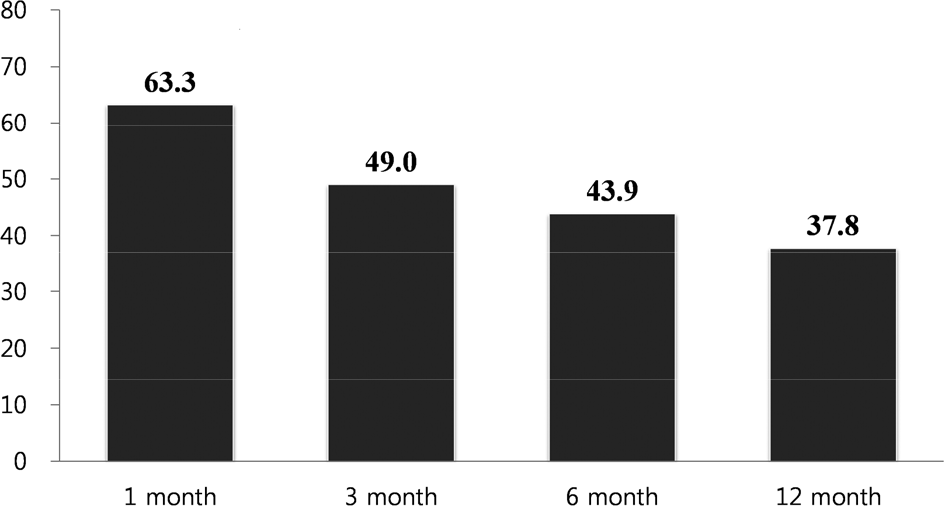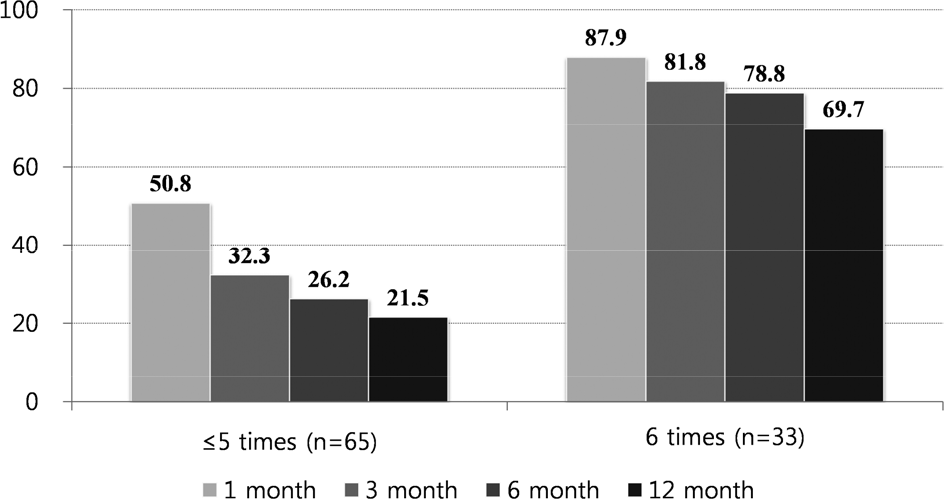Abstract
Background
This study evaluated the continuous abstinence rates from smoking at 12-month after a hospital-based smoking cessation program was applied for smokers hospitalized for acute myocardial infarction.
Methods
Among those who are hospitalized for acute myocardial infarction from January 2012 to December 2013, ninety-eight smokers agreed to quit smoking were eligible for follow up to 12 months. Each of them underwent six consecutive sessions (first during admission, the other 5 sessions after discharge) of behavioral modification, counseling for withdrawal symptoms, and anti-smoking advices by a trained nurse. Exhaled carbon monoxide measurements less than 6 ppm were used to confirm the smoking cessation status of each participant.
Results
Mean age of all participants was 55.2±10.8 years old, and their continuous abstinence rates at 1, 3, 6, 12 months were 63.3%, 49.0%, 43.9%, and 37.8% for each. The continuous abstinence rate from smoking after 12 months was 69.7% and significantly higher in those who completed the 6 sessions than 21.5% in those who completed 5 sessions or less (P<0.001). After adjustment for general and smoking-related characteristics, multivariate logistic regression analysis revealed that full participation relative to 5 or less participation was significantly associated with higher continuous abstinence rate from smoking at 12 months (odds ratio: 7.96; 95% confidence interval: 2.07–30.55).
Conclusions
The consistency of participating in a hospital-based smoking cessation program, described herein, significantly improved success rates of smoking cessation in patients discharged after acute myocardial infarction. Hospital-based smoking cessation program based on education and counseling should be included as an important part of patient management for acute myocardial infarction.
Go to : 
References
1. Burns DM. Epidemiology of smoking-induced cardiovascular disease. Prog Cardiovasc Dis. 2003; 46(1):11–29.

2. Prescott E, Hippe M, Schnohr P, Hein HO, Vestbo J. Smoking and risk of myocardial infarction in women and men: longitudinal population study. BMJ. 1998; 316(7137):1043–7.

3. Wilson K, Gibson N, Willan A, Cook D. Effect of smoking cessation on mortality after myocardial infarction: metaanalysis of cohort studies. Arch Intern Med. 2000; 160(7):939–44.
4. Critchley JA, Capewell S. Mortality risk reduction associated with smoking cessation in patients with coronary heart disease: a systematic review. JAMA. 2003; 290(1):86–97.
5. Kinjo K, Sato H, Sakata Y, Nakatani D, Mizuno H, Shimizu M, et al. Impact of smoking status on longterm mortality in patients with acute myocardial infarction. Circ J. 2005; 69(1):7–12.

6. Gerber Y, Rosen LJ, Goldbourt U, Benyamini Y, Drory Y. Israel Study Group on First Acute Myocardial Infarction. Smoking status and longterm survival after first acute myocardial infarction a population-based cohort study. J Am Coll Cardiol. 2009; 54(25):2382–7.
7. Rigotti NA, Clair C, Munafò MR, Stead LF. Interventions for smoking cessation in hospitalised patients. Cochrane Database Syst Rev. 2012; 5:CD001837.

8. Seol SY, Lee SJ, Jeong MH, Rhee JA, Choi JS, Hwang SH, et al. Clinical outcomes of persistent smoking in patients with acute myocardial infarction who underwent percutaneous coronary intervention. 2011; 80(5):562–70.
9. Godtfredsen NS, Osler M, Vestbo J, Andersen I, Prescott E. Smoking reduction, smoking cessation, and incidence of fatal and non-fatal myocardial infarction in Denmark 1976–1998: a pooled cohort study. J Epidemiol Community Health. 2003; 57(6):412–6.

10. Iversen B, Jacobsen BK, L⊘chen ML. Active and passive smoking and the risk of myocardial infarction in 24,968 men and women during 11 year of follow-up: the Troms⊘ Study. Eur J Epidemiol. 2013; 28(8):659–67.
11. Kim HE, Song YM, Kim BK, Park YS, Kim MH. Factors associated with persistent smoking after the diagnosis of cardiovascular disease. Korean J Fam Med. 2013; 34(3):160–8.

12. Sim DS, Kim JH, Jeong MH. Differences in clinical outcomes between patients with ST-elevation versus non-ST-elevation acute myocardial infarction in Korea. Korean Circ J. 2009; 39(8):297–303.

13. Krumholz HM, Cohen BJ, Tsevat J, Pasternak RC, Weinstein MC. Cost-effectiveness of a smoking cessation program after myocardial infarction. J Am Coll Cardiol. 1993; 22(6):1697–702.

14. Van Spall HG, Chong A, Tu JV. Inpatient smoking-cessation counseling and all-cause mortality in patients with acute myocardial infarction. Am Heart J. 2007; 154(2):213–20.

15. Dawood N, Vaccarino V, Reid KJ, Spertus JA, Hamid N, Parashar S. PREMIER Registry Investigators. Predictors of smoking cessation after a myocardial infarction: the role of institutional smoking cessation programs in improving success. Arch Intern Med. 2008; 168(18):1961–7.
16. Dornelas EA, Sampson RA, Gray JF, Waters D, Thompson PD. A randomized controlled trial of smoking cessation counseling after myocardial infarction. Prev Med. 2000; 30(4):261–8.

17. Jun WH, Yun HS. Effects of smoking cessation education for patients with percutaneous coronary intervention. 2012; 24(3):274–83.
18. Kong JH, Ha Y. Effects of a smoking cessation program including telephone counseling and text messaging using stages of change for outpatients after a myocardial infarction. 2013; 43(4):557–67.
19. Jung KY, Yoo SH, Ma SH, Hong SH, Lee YS, Shim UY, et al. Inpatient smoking cessation program and its success rate for abstinence among Korean smokers. Korean J Fam Med. 2009; 30(7):503–10.

20. Kang SH, Suh JW, Choi DJ, Chae IH, Cho GY, Youn TJ, et al. Cigarette smoking is paradoxically associated with low mortality risk after acute myocardial infarction. Nicotine Tob Res. 2013; 15(7):1230–8.

21. Weiner P, Waizman J, Weiner M, Rabner M, Magadle R, Zamir D. Smoking and first acute myocardial infarction: age, mortality and smoking cessation rate. Isr Med Assoc J. 2000; 2(6):446–9.
Go to : 
 | Figure 1.Continuous abstinence rates from smoking decreased from 63.3% at 1 month to 37.8% at 12 month in patients discharged after acute myocardial infarction who participated in hospital-based smoking-cessation program. |
 | Figure 2.Continuous abstinence rates from smoking were higher in patients discharged after acute myocardial infarction who participated in smoking-cessation program of 6 times versus ≤5 times. |
Table 1.
General characteristics of subjects according to the frequency of participating in smoking cessation program
| Total (n=98) | ≤ 5 times (n=65) | 6 times (n=33) | Pa | |
|---|---|---|---|---|
| n | n | n | ||
| Age, y | 55.2±10.8 | 55.9±10.7 | 53.8±11.0 | 0.362 |
| <60 | 68 (69.4) | 20 (69.2) | 23 (69.7) | 0.962 |
| ≥ 60 | 30 (30.6) | 10 (30.8) | 10 (30.3) | |
| Duration of education, y | ||||
| ≤ 9 | 40 (40.8) | 28 (43.1) | 12 (36.4) | 0.523 |
| ≥ 10 | 58 (59.2) | 37 (56.9) | 21 (63.6) | |
| Health insurance | ||||
| Medical aid | 8 (8.2) | 5 (7.7) | 3 (9.1) | 0.811 |
| National health insurance | 90 (91.8) | 60 (92.3) | 30 (90.9) | |
| Family type | ||||
| Living alone | 25 (25.5) | 18 (27.7) | 7 (21.2) | 0.268 |
| Living with family | 65 (66.3) | 40 (61.5) | 25 (75.8) | |
| Non-response | 8 (8.2) | 7 (10.8) | 1 (3.0) | |
| Occupation | ||||
| Manual | 44 (44.9) | 26 (40.0) | 18 (54.5) | 0.182 |
| Non-manual | 14 (14.3) | 12 (18.5) | 2 (6.1) | |
| Others (unemployed, housewife, non-response) | 40 (40.8) | 27 (41.5) | 13 (39.4) | |
| Alcohol drinking | ||||
| No | 64 (65.3) | 43 (66.2) | 21 (63.6) | 0.805 |
| Yes | 34 (34.7) | 22 (33.8) | 12 (36.4) | |
| Hypertension | ||||
| Absent | 65 (66.3) | 43 (66.2) | 22 (66.7) | 0.960 |
| Present | 33 (33.7) | 22 (33.8) | 11 (33.3) | |
| Diabetes mellitus | ||||
| Absent | 78 (79.6) | 49 (75.4) | 29 (87.9) | 0.147 |
| Present | 20 (20.4) | 16 (24.6) | 4 (12.1) | |
| Dyslipidemia | ||||
| Absent | 89 (90.8) | 58 (89.2) | 31 (93.9) | 0.446 |
| Present | 9 (9.2) | 7 (10.8) | 2 (6.1) | |
| Past history of coronary heart disease | ||||
| No | 91 (92.9) | 60 (92.3) | 31 (93.9) | 0.767 |
| Yes | 7 (7.1) | 5 (7.7) | 2 (6.1) | |
| Killip class | ||||
| Ⅰ | 93 (94.9) | 62 (95.4) | 31 (93.9) | 0.759 |
| Ⅱ-Ⅳ | 5 (5.1) | 3 (4.6) | 2 (6.1) |
Table 2.
Smoking-related characteristics of subjects according to the frequency of participating in smoking cessation program
| Total (n=98) | ≤ 5 times (n=65) | 6 times (n=33) | Pa | |
|---|---|---|---|---|
| n | n | n | ||
| Presence of smokers among family members | 0.834 | |||
| Absent | 22 (22.4) | 15 (23.1) | 7 (21.2) | |
| Present | 76 (77.6) | 50 (76.9) | 26 (78.8) | |
| Previous exposure to anti-smoking education | 0.979 | |||
| No | 86 (87.8) | 57 (87.7) | 29 (87.9) | |
| Yes | 12 (12.2) | 8 (12.3) | 4 (12.1) | |
| Previous attempts to quit smoking | 0.026 | |||
| No | 42 (42.9) | 33 (50.8) | 9 (27.3) | |
| Yes | 56 (57.1) | 32 (49.2) | 24 (72.7) | |
| Amount of smoking | 0.139 | |||
| <1 pack | 71 (72.4) | 44 (67.7) | 27 (81.8) | |
| ≥ 1 pack | 27 (27.6) | 21 (32.3) | 6 (18.2) | |
| Age at starting smoking | 0.831 | |||
| <20 yr | 49 (50.0) | 33 (50.8) | 16 (48.5) | |
| ≥ 20 yr | 49 (50.0) | 32 (49.2) | 17 (51.5) | |
| Duration of smoking, y | 0.577 | |||
| <30 | 32 (32.7) | 20 (30.8) | 12 (32.7) | |
| ≥ 30 | 66 (67.3) | 45 (69.2) | 21 (67.3) | |
| Participation in a heart rehabilitation program | 0.171 | |||
| 0 sessions | 39 (39.8) | 29 (44.6) | 10 (30.3) | |
| ≥ 1 sessions | 59 (60.2) | 36 (55.4) | 23 (69.7) | |
| Participation in a follow-up heart education | <0.001 | |||
| 0 sessions | 38 (38.8) | 35 (53.8) | 3 (9.1) | |
| ≥ 1 sessions | 60 (61.2) | 30 (46.2) | 30 (90.9) |
Table 3.
OR (95% CI) for persistent smoking cessation after 6 and 12 month according to the frequency of participating in smoking cessation program in patient with myocardial infarction
| After 6 month | After 12 month | |
|---|---|---|
| OR (95% CI) | OR (95% CI) | |
| Frequency of smoking cessation program | ||
| ≤ 5 times | 1.00 | 1.00 |
| 6 times | 10.36 (2.36–45.59) | 7.96 (2.07–30.55) |
Abbreviations: OR, odds ratio; CI, confidence interval. Adjusted for age, duration of education, health insurance, family type, occupation, alcohol drinking, hypertension, diabetes mellitus, dyslipidemia, past history of coronary heart disease, Killip class, presence of smokers among family members, previous exposure to anti-smoking education, previous attempts to quit smoking, amount of smoking, age at starting smoking, duration of smoking, participation in a heart rehabilitation program, and participation in a follow-up heart education




 PDF
PDF ePub
ePub Citation
Citation Print
Print


 XML Download
XML Download